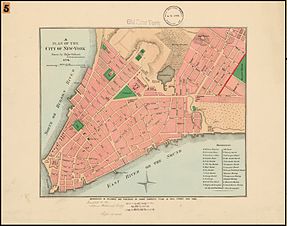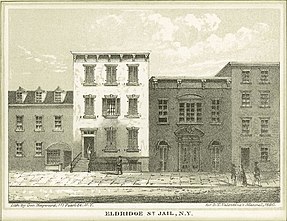Eldridge Street


Eldridge Street is a street in the Lower East Side and Chinatown neighborhoods of Manhattan in New York City, running from Houston Street in the north to East Broadway in the south. Originally called Third Street according to the numbering system for the Delancey Farm Grid, it was named in 1817 for Lt. Joseph C. Eldridge, whose unit was ambushed by Indian allies of the British in Upper Canada during the War of 1812.[1]
Notable locations[edit]

The Eldridge Street Synagogue at 12 Eldridge Street opened in 1887 and served Congregation Kahal Adath Jeshurun.[2] It is one of the first synagogues in the United States erected by Eastern European Jews (Ashkenazis).[3][4] Since 2007, the synagogue houses the Museum at Eldridge Street.[5]
Eddie Cantor lived at 19 Eldridge Street.[6]
20 Eldridge Street[7] was Hook and Ladder Company Eagle No. 4 in the mid-19th century. Today the building, once two stories high, now five, is a Buddhist temple.
The New York County Jail, better known as the Eldridge Street Jail, was located at 22 Eldridge Street[8] and operated from 1836 to 1862,[9] when it was replaced by a new jail on Ludlow Street. The jail building started out as a three-story private home and before becoming a jail was a first a school and then city watchhouse.
American lyricist Ira Gershwin was born at 60 Eldridge Street.[10]
Musicians Thurston Moore and Kim Gordon of the American rock band Sonic Youth lived at 84 Eldridge Street in the 1980s.[11]
105-107 Eldridge Street was the Eldridge Street Police Station from 1869 to 1912. Danish-American photographer and social reformer Jacob Riis took several photographs of the inmates there and documented their squalid living conditions in his 1890 book How the Other Half Lives.
Gallery[edit]
- The buddhist temple in 2017
- A store with Chinese signage on Eldridge Street
- The Assafa Islamic Center, a mosque on Eldridge Street
References[edit]
- ^ Moscow, Henry (1978). The Street Book: An Encyclopedia of Manhattan's Street Names and Their Origins. New York: Hagstrom Company. p. 46. ISBN 978-0-8232-1275-0.
- ^ Polland, Annie; Moyers, Bill (2009). Landmark of the Spirit: The Eldridge Street Synagogue. Yale University Press. p. 32. ISBN 978-0-300-12470-5.
- ^ New York City Landmarks Preservation Commission; Dolkart, Andrew S.; Postal, Matthew A. (2009). Postal, Matthew A. (ed.). Guide to New York City Landmarks (4th ed.). New York: John Wiley & Sons. p. 45. ISBN 978-0-470-28963-1.
- ^ Dunlap, David W. (2004). From Abyssinian to Zion: A Guide to Manhattan's Houses of Worship. New York: Columbia University Press. pp. 60–61. ISBN 0-231-12543-7.
- ^ Rothstein, Edward (December 1, 2007). "Return of a Long-Dormant Island of Grace". The New York Times. ISSN 0362-4331. Archived from the original on April 27, 2024. Retrieved May 11, 2024.
- ^ "MY MANHATTAN; On Eldridge Street, Yesteryear's Schul" The New York Times, October 2, 1998
- ^ "Maps of the City of New-York". Perris & Browne. Retrieved 2017-05-14.
- ^ "Eldridge Street Jail Imprisonment For Debt". New York Tribune. New York. 1856-12-09. Retrieved 2017-05-14.
- ^ A. E. Costello, Our Police Protectors . History of the New York Police From the Earliest Period to the Present Time, Chas. F. Roper & Co., 1884, p. 242
- ^ "Widow of Ira Gershwin Endows Literacy Center" The New York Times, March 25, 1987
- ^ Elie Perler (2015-02-15). "When Thurston Moore and Kim Gordon of Sonic Youth Lived on Eldridge Street". Bowery Boogie. Archived from the original on 2022-08-07. Retrieved 2017-05-14.



